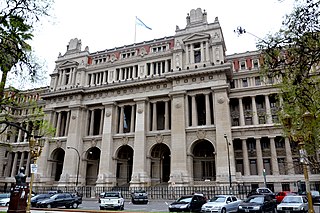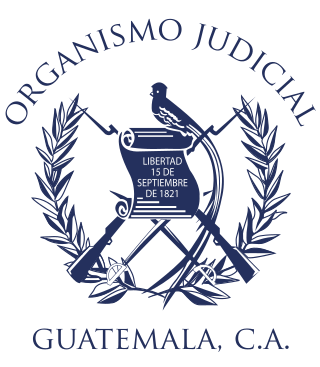
The Supreme Court of Justice of Buenos Aires (in Spanish: Suprema Corte de Justicia de Buenos Aires) is the body created in 1875 that exercises the Judicial Power in the province of Buenos Aires, one of the 24 subnational entities of Argentina.

The Supreme Court of Justice of Buenos Aires (in Spanish: Suprema Corte de Justicia de Buenos Aires) is the body created in 1875 that exercises the Judicial Power in the province of Buenos Aires, one of the 24 subnational entities of Argentina.
To be a member of the Supreme Court, the following is required: [1]
The appointment of Supreme Court justices is a power shared between the Executive Branch and the provincial Legislature. The process for doing so is expressly established in the provincial Constitution, in Article 175. There it is established that the Governor appoints the candidate and the Senate, with a special majority of two thirds of the members present, must validate it in a public session. Once the two requirements are fulfilled and before taking office, they must be sworn in, before the president of the supreme court (art. 179).
The Article 162 of the provincial Constitution establishes that the presidency of the Supreme Court of Justice shall rotate annually among its members, beginning with the oldest of age.
Its current composition is formed by Daniel Fernando Soria (since 2002) and is holding his second term as its president since 2020, Luis Esteban Genoud (since 2002), who is its vice president, Hilda Kogan (since 2002), Eduardo Julio Pettigiani (since 1996) and Sergio Gabriel Torres (since 2019). [2]
The government of Argentina, within the framework of a federal system, is a presidential representative democratic republic. The president of Argentina is both head of state and head of government. Executive power is exercised by the president. Legislative power is vested in the National Congress. The Judiciary is independent from the Executive and from the Legislature, and is vested in the Supreme Court and the lower national tribunals. From the own government is also called Presidency of the Nation.

The president of Argentina is both head of state and head of government of Argentina. Under the national constitution, the president is also the chief executive of the federal government and commander-in-chief of the armed forces.

Argentina is divided into twenty-three federated states called provinces and one called the autonomous city of Buenos Aires, which is the federal capital of the republic as decided by the Argentine Congress. The provinces and the capital have their own constitutions and exist under a federal system.

Buenos Aires, officially the Buenos Aires Province, is the largest and most populous Argentine province. It takes its name from the city of Buenos Aires, the capital of the country, which used to be part of the province and the province's capital until it was federalized in 1880. Since then, in spite of bearing the same name, the province does not include Buenos Aires city, though it does include all other parts of the Greater Buenos Aires metropolitan area. The capital of the province is the city of La Plata, founded in 1882.

The Chamber of Deputies, officially the Honorable Chamber of Deputies of the Argentine Nation, is the lower house of the Argentine National Congress. It is made up of 257 national deputies who are elected in multi-member constituencies corresponding with the territories of the 23 provinces of Argentina by party list proportional representation. Elections to the Chamber are held every two years, so that half of its members are up in each election, making it a rare example of staggered elections used in a lower house.

The Supreme Court of Justice of the Nation is the Mexican institution serving as the country's federal high court and the spearhead organisation for the judiciary of the Mexican Federal Government.

The Supreme Court of Argentina, officially known as the Supreme Court of Justice of the Argentine Nation, is the highest court of law of the Argentine Republic. It was inaugurated on 15 January 1863. However, during much of the 20th century, the Court and the Argentine judicial system in general, lacked autonomy from the executive power. The Court was reformed in 2003 by the decree 222/03.

The United Provinces of the Río de la Plata, earlier known as the United Provinces of South America, was a name adopted in 1816 by the Congress of Tucumán for the region of South America that declared independence in 1816, with the Sovereign Congress taking place in 1813, during the Argentine War of Independence (1810–1818) that began with the May Revolution in 1810. It originally comprised rebellious territories of the former Spanish Viceroyalty of the Río de la Plata dependencies and had Buenos Aires as its capital.

The current Constitution of Argentina dates from 1853. The Constitution of Argentina of 1853 was approved in 1853 by almost all of the provincial governments at that moment with the exception of Buenos Aires Province, which remained separate from the Argentine Confederation until 1859. After several modifications to the original constitution and the return of power to Buenos Aires' Unitarian Party, it was sanctioned on May 1, 1853, by the Constitutional Convention gathered in Santa Fe, and it was promulgated by the provisional director of the national executive government Justo José de Urquiza, a member of the Federalist Party. Following the short-lived constitutions of 1819 and 1826, it was the third constitution in the history of the country.

Ricardo Luis Lorenzetti is an Argentine judge graduated from the National University of the Littoral, Argentina, with a long national and international career. He used to be Chief Justice of the Supreme Court of Argentina (2007–2018), proposed by President Néstor Kirchner and approved by the Senate, assuming his position on December 12, 2004, covering the vacancy caused by the resignation of Justice Adolfo Vázquez. On November 7, 2006, he was appointed Chief Justice, officiated as of January 1, 2007. Currently, he is one of the five Justices of the Supreme Court. He was President of the Commission for the preparation of the Parliamentary Act to reform, update and unify the Civil and Commercial Codes of the Argentine Nation, Presidential Decree 191/2011.

The Supreme Court of Justice of Colombia in Bogotá is the highest judicial body in civil and penal matters and issues of criminal and civil procedure in Colombia.

Carlos Santiago Fayt was an Argentine lawyer, politician, academic and a member of the Supreme Court of Justice of Argentina from 1983 to 2015.

The Chamber of Deputies of Buenos Aires Province is the lower house of the Legislature of Buenos Aires Province, the largest and most populous of Argentina's provinces. It is made up of 92 deputies elected in eight multi-member constituencies known as Electoral Sections. The number of deputies that correspond to each of the electoral sections is proportional to their population, as observed in the results of every nationwide census conducted in Argentina every 10 years. Seats may only be added to adjust the proportionality of each section, but never reduced.

The Supreme Court of Uruguay is the highest court of law and last resort in the Oriental Republic of Uruguay. It serves as the highest appeals court, and appoints and oversees all other judges. Established on 28 October 1907, it is housed in the Palacio Piria, a masterpiece of eclectic architecture from 1917.

The Supreme Court of the Dominican Republic is the highest court existing in the Republic and is, therefore, the head of the judiciary in the country.

The Supreme Court of Justice of Guatemala, or CSJ, is the highest court within Guatemala's judiciary branch. As the highest Court in Guatemala, it has jurisdiction over all legal matters that may arise in the country. The Court sits in the Palace of Justice, in Zone 1 of Guatemala City. The current president of the Supreme Court of Justice is Oscar Cruz Oliva, who was voted in by the Congress of the Republic of Guatemala.

Horacio Daniel Rosatti is an Argentine lawyer, politician and a member of the Supreme Court of Argentina since 2016, designated by president Mauricio Macri's and the Senate's approval. In September 2021 he was elected President of the court by his peers, and took office on 1 October.
Eduardo Néstor de Lázzari was an Argentine lawyer and judge, justice president of the Supreme Court of Justice of Buenos Aires between 2004 and 2005, between 2012 and 2013, and from 24 April 2019 to 18 April 2020.

The Senate of Buenos Aires Province is the upper house of the Legislature of Buenos Aires Province, the largest and most populous of Argentina's provinces. It comprises 43 members elected in eight multi-member constituencies known as Electoral Sections. The number of senators that correspond to each of the electoral sections is proportional to their population, as observed in the results of every nationwide census conducted in Argentina every 10 years. Seats may only be added to adjust the proportionality of each section, but never reduced.
The Argentine presidential line of succession is the order in which officials may assume the office of the president of Argentina in the case of vacancy due to illness, death, resignation or impeachment.